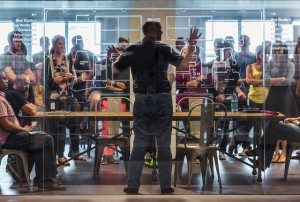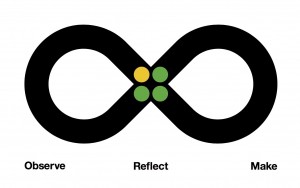IBM Design Thinking: A Framework To Help Teams Continuously Understand and Deliver
January 21, 2016 | Written by: Steve Hamm
Share this post:
Two years ago, after IBM executives decided to build a new application development platform for cloud computing, we tore up our old product development playbook. In its place, we developed a new approach: IBM Design Thinking.
Following this new framework, IBM’s designers, developers, marketers and others combined forces to create Bluemix, which reimagines the cloud app development experience. Since then, Bluemix has attracted more than one million developers and emerged as one of IBM’s most important software platforms.
Since then, we’ve applied it to almost one hundred new IBM products and services and an uncountable number of custom solutions for our clients. We are on track to hire 1000 formally trained designers, and we’ve opened 26 IBM Studios worldwide where designers work collaboratively with engineers, offering managers, sales people, lawyers, marketers and everyone else who impacts our users’ experiences.
Today, we are thrilled and proud to announce the latest revision and first-ever public release of IBM Design Thinking.
An introduction to IBM Design Thinking
IBM Design Thinking is a scalable framework to help teams understand and deliver—continuously.
You begin by making a conscious commitment, as a team, to prioritize your users over other, sometimes competing, business concerns.
In order to move fast, you put in place a well-rounded, multi-disciplined team. This is essential to move faster and work smarter in service of your users. When empowered whole teams can reject or commit to ideas in real-time, possibilities become reality.
And finally, you consider that everything is a prototype. Everything. This means your daily work artifacts and released, user-facing solutions. You restlessly reinvent, always keeping your focus on users’ needs and the ever-changing technological landscape as an opportunity to re-think how a problem can be solved.
The heart of IBM Design Thinking is a set of behaviors focused on discovering users’ needs and envisioning a better future. We call it the Loop. The Loop is a continuous cycle of observing, reflecting and making.
- Observe to see what others look past. Take it all in with open eyes and ears to find out what’s important to your users and also see how your ideas hold up to their expectations.
- Reflect to synthesize what you and your teammates have learned, articulate a point of view and come up with a plan.
- Make to give concrete form to abstract ideas and turn intent into reality.
While you can start your journey anywhere on the Loop, we recommend beginning with reflection to form your intent. Then make or observe to open up the possibilities and continuously build on your understanding.
The keys to scale
 In today’s world, many, if not most, problems are solved by teams working together, often from many different geographical locations. It’s difficult to apply these rapid iteration frameworks to teams like this. And yet, if you’re restricted to so-called “two pizza” teams, then you probably don’t really have the team in place to solve true, end-to-end user experience needs. So to work like this at the scale of enterprise business, we’ve established three keys for teams to practice design thinking.
In today’s world, many, if not most, problems are solved by teams working together, often from many different geographical locations. It’s difficult to apply these rapid iteration frameworks to teams like this. And yet, if you’re restricted to so-called “two pizza” teams, then you probably don’t really have the team in place to solve true, end-to-end user experience needs. So to work like this at the scale of enterprise business, we’ve established three keys for teams to practice design thinking.
- Hills turn human needs into project goals by aligning a whole-team around a common understanding of success, without prescribing the tactics that sub-teams should be given the autonomy to figure out on their own.
- Playbacks provide a safe space for team members and, sometimes, users, to voice their feedback concerning your effort. They reveal alignment and misalignment about what you intend to deliver, and break down the organizational silos and hierarchy that often complicate delivery.
- Sponsor users are real people, from outside your organization, who represent the most extreme use cases of a given targeted persona. They are active participants who co-create with you and your team. Every interaction you have together closes the gap between your assumptions and their reality.
IBM Design Thinking for all
We began our own IBM Design Thinking journey three years ago. Since then, we’ve learned a lot about how design thinking works at scale. And so now we think it’s time to share that knowledge with you. Our goal? Simply to help improve product quality, customer satisfaction and organizational agility–not only for IBM, but for other organizations that choose to work in the same way.
So today we’re making the framework freely available and open to all. In your exploration, if you come across a new or better way to apply IBM Design Thinking please share it with us.
Whether you’re a team of four or four hundred, hopefully you can use IBM Design Thinking to effect your own positive change in the world, even as you seek to understand it.
So have at it.
Houston, We’re Live Streaming
Since people around the world first gathered around black-and-white televisions to watch the 1969 moon landing, the general public has been fascinated by space, craving more visual information about the final frontier. At NASA today, we are on a mission to find new ways to share our discoveries on Earth and in space. Before the […]
An Open Letter to the President-Elect
International Business Machines Corporation Office of the Chairman, President and Chief Executive Officer One New Orchard Road Armonk, New York 10504-1783 November 14, 2016 Mr. Donald J. Trump Office of the Presidential Transition 1800 G Street, NW Washington, DC 20006 Dear Mr. President-elect: Congratulations on your election as the 45th president of the United States. […]
How New Algorithms Are Helping to Predict Food Dangers
Thanksgiving in the United States, like other holidays around the world, places food at the center of a joyful celebration — and at the forefront of our minds. As we plan, shop, prepare, cook and share our celebratory meals, we are careful to include not only flavors that our loved ones enjoy, but also foods […]


